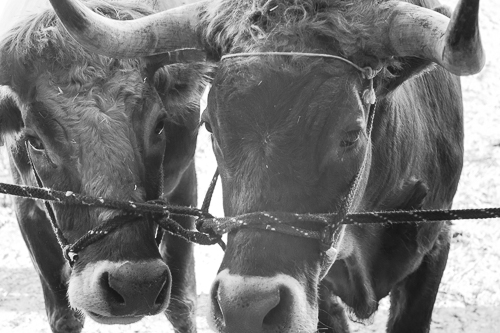We went back to Aia a few days after we had visited Joxean Bollain, the pig farmer. Having passed the village of Aia, we drove in a lovely landscape with meadows, groves, and scattered farms in a hilly terrain. Since there were no signs, it was rather difficult to find the Pagadizabal farm. There, the teenage son Joseba was preparing to make apple juice together with Jose, a man in his sixties. They had already filled the press with apples, remaining only to put a lid on the top and moving it downwards by means of a ratchet. After just a few turns, we were offered fresh, delicious apple juice.
Having arrived at a busy farm, another farmer had arrived while we were watching the apple pressing. He had come to buy two rams in order to spread their genes among his ewes. Having restrained both of them, he put them in his car and went away. The rams had nice, curved horns and, since there are so few of them, it’s important to pass on their genes to maintain diversity. Actually, we followed the farmer with the rams in his car for a part of the way until we arrived at a meadow where there was a flock of sheep. There, Peio, the father of Joseba let out their dog Lantz, a border collie. Letting him enter the meadow, Peio gave him short commands in Basque, which was enough to make him herd the sheep where Peio wanted. Having led them into a tight spot, he could inspect their feet, which are vulnerable, he told my guide.
Having gone back to the farm, we could appreciate the beauty of the surroundings of the Pagadizabal farm. Like the farm of Joxean Bollain, it’s located on the top of a steep hill and surrounded by groves, meadows, and hills. Birds of prey were circling overhead and sheep’s and cows’ bells could be heard in the distance. Again Peio let Lantz herd sheep, first a small flock on the top of a steep hill, then he was ordered to herd another one at the bottom of the hill. Obviously, a shepherd dog like Lantz is indispensable for the Pagadizabal family. Peio also let Lantz guide some geese which he did with ease.
There were also several cows and calves grazing in the steep hillside. Peio told my guide that the cows bear calves unattended, but since it’s so steep, sometimes the calves fall down the hillside. In order to help the calf, they first have to restrain the cow since she’s very protective of her offspring, in particular for the first 48 hours.
The hills around the farm were covered with fresh grass, and since their tractor had broken down, the Pagadizabal family first cut the grass with a scythe. At the same time, one of them prepared two oxen to pull a sled. It was a pleasant, but totally unexpected sight to watch oxen being walked next to each other, then having a wooden device put on their necks and having fastened everything by means of ropes. Being animals of habit, my guide was told that if an ox has been working on the left side once, it has to always work on the left side and vice versa. Having prepared both sled and oxen, the driver made them walk to the meadow where all the family raked the grass together and put it on the sled. Finally, the oxen pulled everything up to a barn where the grass was put in a barn. The oxen were completely docile because they had been castrated. In fact, there were several more oxen at the farm, which were not castrated and since they are so strong, they were getting dangerous. Peio was planning to castrate them too, but he was waiting for a cold day. I imagine they will let the oxen stay outside a whole night in order to make them easier to handle, but I didn’t ask my guide to enquire further.
Before we left, Peio ordered Lantz to herd the sheep inside a barn. Then, it just remained to thank the Pagadizabal family for letting us watch them at work in such lovely surroundings.

